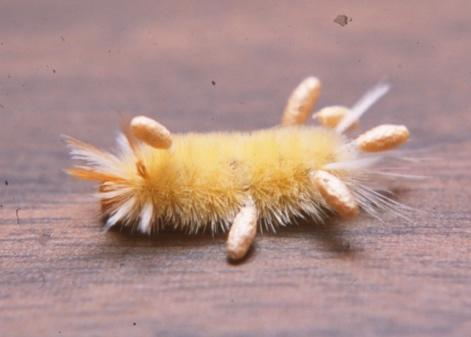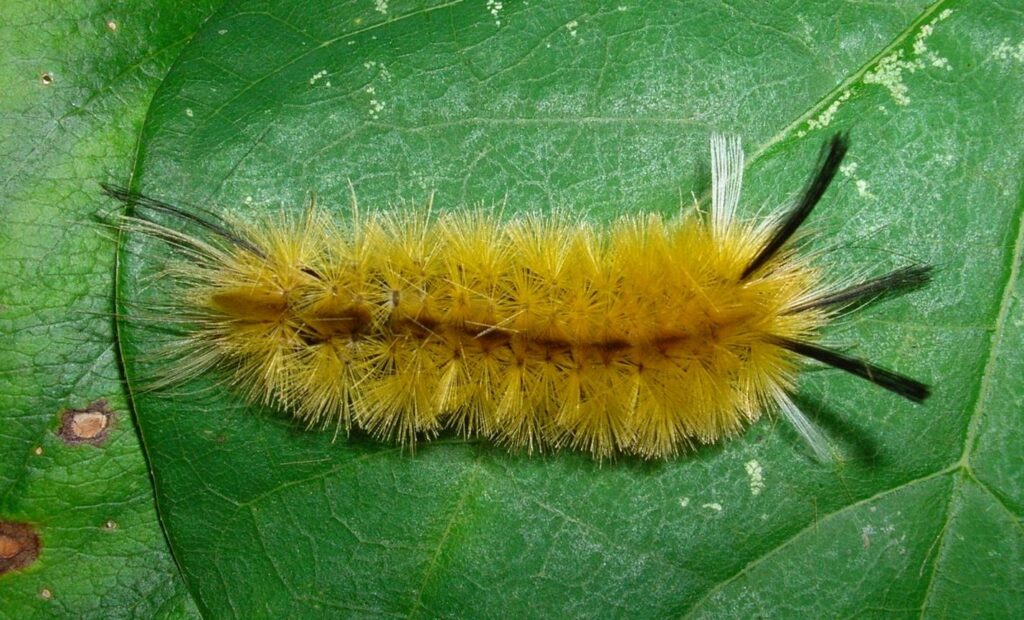by Ilse Gebhard, KAWO member
I called the caterpillar “Bunny” because it reminded me of those fuzzy kids’ slippers with rabbit ears. Bunny was hanging by a strand of silk from the sycamore (Platanus occidentalis) in our front yard and it clearly needed a good home, namely a jar with fresh sycamore leaves.

Bunny was about one inch long and had an orange head. It was covered with pale orange hair and had a pair of white and orange hair pencils on each side of the second and third thoracic segments and two white hair pencils on the rear segment.

David L. Wagner’s book Caterpillars of Eastern North America identifies it as the sycamore tussock moth (Halysidota harrisii), a sycamore specialist. It is similar to the closely related banded tussock moth (Halysodota tessellaris), which I had found previously, and which has a black head, white and black hair pencils, and darker orange hair.

After nibbling on sycamore leaves for a few days, Bunny stopped feeding. Since it was late August, I expected it to spin a cocoon and pupate. Instead, I was shocked one morning to discover ten tiny, off-white silky cocoons attached to the hairs of the caterpillar. The cocoons measured five millimeters (three sixteenths of an inch) and there were black spots on the skin of the caterpillar where the larva, that had spun the cocoons, had emerged. Bunny was, of course, dead.
In the interest of learning, I overwintered the cocoons and on June 10 the following spring tiny insects, half the size of their cocoons, emerged. Inspecting one of them under the microscope, and studying my insect books, confirmed them to be brachonid wasps.
Brachonid wasps parasitize many different types of insects. In the case of butterflies and moths, they lay their eggs on the caterpillars. Once the wasp larvae emerge from their eggs, they burrow into the host and feed until they are ready to pupate. They then emerge through the skin, attach themselves to the caterpillar and form their cocoon, which is what I had observed.
The following year I found another “Bunny” in mid-August. It looked a little bedraggled, having lost some of its hair pencils. Did it have a narrow escape from a bird? It was a year we had cuckoos around all summer and they are known to love hairy caterpillars.
After happily munching sycamore leaves in a jar for seven days, “Bunny II” spun a cocoon on the side of the jar, incorporating its hair. Inside the cocoon could be seen the half-inch long brown pupa. Looking forward to having a moth emerge in spring, I was again disappointed, as late in September a larva emerged instead. The larva pupated and ten days later a parasitic Tachinid fly emerged. This was the first time, but not the last, that I observed a species of moth or butterfly parasitized by two different insect species, and it had to be such a cute rascal.
Alas, no more Bunnys after that. The sycamore was struck by lightning and leaning towards the house. It was huge and would have obliterated the house had it come down in a storm. On a plus note, one of the culprits of my spring allergy is sycamore pollen.
